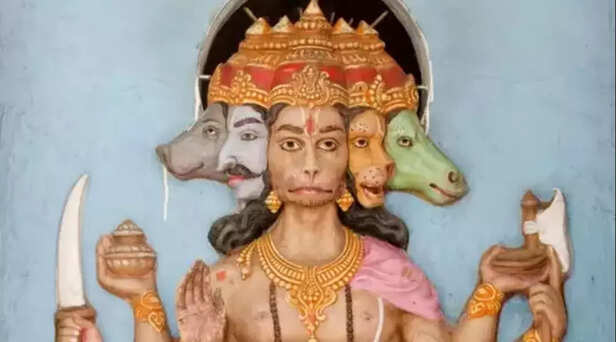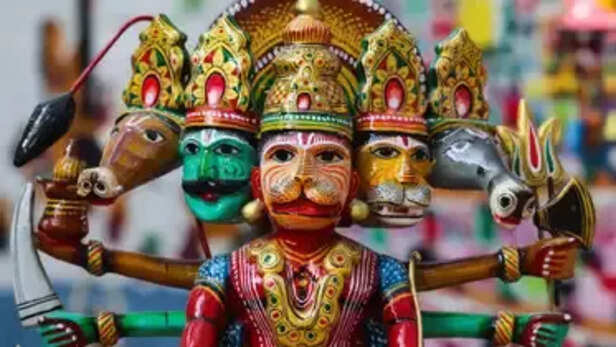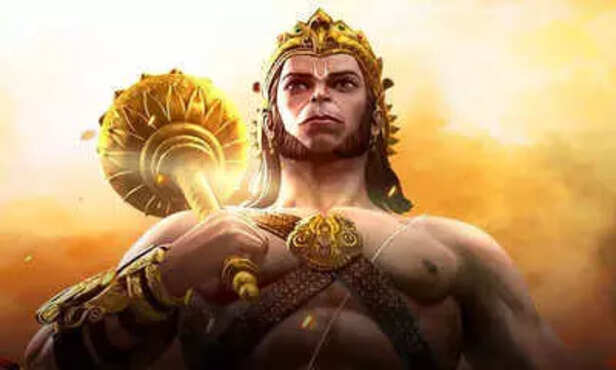Why did Hanuman Take the Panchmukhi form?—The Five-Faced Guardian of Dharma
Ankit Gupta | Apr 12, 2025, 22:34 IST
Hanuman did not take the Panchmukhi form for ego or display. He took it out of necessity, to fulfill his dharma as a servant of the Divine. Panchmukhi Hanuman remains a towering symbol of balance, power, and spiritual sovereignty. He is not just the destroyer of Ahiravana but of the entire network of maya that keeps the soul bound.
“Yatra yatra Raghunātha-kīrtanam, Tatra tatra kr̥tamasta kāñjalim;
Bāṣpa-vāri paripūrṇa-locanam, Mārutim namata rākṣasāntakam.”
“Wherever the glories of Lord Rama are sung, there, with folded hands and tear-filled eyes, stands Hanuman—the vanquisher of demons. To him we offer our obeisance.”

After the death of Indrajit, the once-proud Lanka trembled with uncertainty. Ravana, the mighty king, found himself consumed by despair and gloom. Desperate and fraying, he turned to one final hope: his estranged brother Ahiravana, a dreaded Rakshasa and master of black magic who ruled the eerie depths of Patala Loka. Known for his mastery over illusion, Ahiravana was invoked by Ravana to perform a heinous act—offer Rama and Lakshmana as human sacrifices to Devi Mahamaya in exchange for victory. Ahiravana, with his unholy powers, agreed to the deal and began his dark preparations.
When Vibhishana, now an ally of Rama, came to know about Ahiravana’s involvement, he rushed to Hanuman with trembling urgency. Vibhishana knew Ahiravana’s cunning ways and feared the worst. But the warning came too late. In the shadows of illusion, Ahiravana had already entered the camp, and using deceptive maya, he kidnapped Rama and Lakshmana, dragging them into the abyss of Patala Loka. With fists clenched and eyes blazing with divine fury, Hanuman dove into the underworld, determined to bring them back before the unthinkable could happen. In the heart of Patala, Hanuman found the two brothers unconscious on an altar, surrounded by eerie chants and Ahiravana preparing for the sacrifice. A fierce battle ensued, but Hanuman could not overpower the sorcerer. Every blow failed, every move countered. Then came the crucial revelation—Ahiravana’s soul was hidden in five mystical lamps placed in five directions. Only if all five were extinguished at the same moment could the demon be vanquished.
The Manifestation of

Realizing the magnitude of the challenge, Hanuman called upon a form so fierce, so majestic, and so multidimensional that it could defy even the limits of time and space. He transformed into Panchmukhi Hanuman, the five-faced embodiment of divine forces. This was not merely a transformation of form, but a manifestation of absolute spiritual force aligned with cosmic purpose. Each of the five faces carried unique energy and meaning. The central and eastern face was his own—Hanuman—representing pure devotion, breath, and unwavering loyalty to dharma. The southern face was Narasimha, the lion-headed destroyer of evil, signifying protection and divine rage. The western face was Garuda, the eagle-faced destroyer of serpents and black magic, representing clarity and transcendence. The northern face was Varaha, the boar incarnation of Vishnu who raised the Earth from deluge, symbolizing grounding and rescue from chaos. And the upward-facing fifth face was Hayagriva, the horse-headed deity of wisdom and mantras, the guardian of divine knowledge.
In this unified yet multi-faceted form, Hanuman took to the sky of the underworld. With immense focus, he extinguished all five lamps simultaneously. At that instant, the protective shield around Ahiravana collapsed, and Hanuman, with one decisive stroke, ended the demon’s existence forever. Rama and Lakshmana were freed, the sacrifice thwarted, and once again, Hanuman proved himself not only as a devotee, but as a divine force manifest. This story is not just a tale of heroism—it is a spiritual allegory, a reflection of inner battles fought against illusions and dark desires.

Each face of Panchmukhi Hanuman is a portal to a deeper truth. These are not merely physical representations, but symbolic archetypes within the seeker. The face of Hanuman represents air or breath (Vayu), invoking control over the mind and senses through devotion. It is the seat of unwavering faith and disciplined service. Narasimha represents fire, burning away fear and darkness, a form to invoke when courage is needed in the face of tyranny. Garuda represents ether, the expansive space where thought and poison are both neutralized; he is the destroyer of hidden venom, whether internal (negative thoughts) or external (evil energies). Varaha, connected to earth, gives strength to rise from despair and anchors the soul in righteousness. Hayagriva, connected to water and the element of sound, is invoked to purify the mind and unlock divine knowledge.
Together, these five forms are the guardians of the five elements, the five directions, and the five internal enemies—Kama (lust), Krodha (anger), Lobha (greed), Moha (attachment), and Ahankara (ego). Panchmukhi Hanuman teaches that only when we simultaneously conquer all five do we become whole. Spiritually, this form also represents the stages of a seeker’s evolution—from discipline and courage to transcendence and finally, liberation through knowledge. It is said that those who meditate upon Panchmukhi Hanuman acquire protection not only from enemies, but from the deeper fears that stalk the soul in silence—doubt, inertia, illusion, and self-ignorance.

In tantric and devotional traditions alike, Panchmukhi Hanuman is considered a powerful Raksha Kavach—a living shield against evil spirits, psychic disturbances, and black magic. He is often invoked in spiritual rituals where devotees need protection during sadhanas or are undergoing planetary afflictions, especially from Shani (Saturn) or Rahu. Temples of Panchmukhi Hanuman exist in many parts of India, most notably in Rameshwaram and Kanchipuram, where he is worshipped as the divine guardian of space and time. Even today, spiritual seekers keep his image or yantra in homes to dispel nightmares and invite blessings of strength, wisdom, and fearlessness.
But Panchmukhi Hanuman is not just a form to be adored from afar. He is the very potential within us. Each face reflects a quality waiting to be awakened: Hanuman as discipline and breath control, Narasimha as valor, Garuda as intuitive flight, Varaha as stability, and Hayagriva as divine memory. When we meditate upon him, we do not simply invite divine energy—we ignite our inner fire. In a world riddled with illusion, toxicity, and fear, the form of Panchmukhi Hanuman reminds us that no force—however dark or complex—can stand against the brilliance of unwavering devotion combined with divine wisdom. He is not merely the slayer of Ahiravana but the destroyer of ignorance, the guardian of dharma, and the guiding light in the dark nights of the soul. To know him is to awaken the force within, and to walk the path of Rama with fearlessness, clarity, and devotion.
Bāṣpa-vāri paripūrṇa-locanam, Mārutim namata rākṣasāntakam.”
“Wherever the glories of Lord Rama are sung, there, with folded hands and tear-filled eyes, stands Hanuman—the vanquisher of demons. To him we offer our obeisance.”
The Dark Hour and the Descent into Patala

Magnificent
After the death of Indrajit, the once-proud Lanka trembled with uncertainty. Ravana, the mighty king, found himself consumed by despair and gloom. Desperate and fraying, he turned to one final hope: his estranged brother Ahiravana, a dreaded Rakshasa and master of black magic who ruled the eerie depths of Patala Loka. Known for his mastery over illusion, Ahiravana was invoked by Ravana to perform a heinous act—offer Rama and Lakshmana as human sacrifices to Devi Mahamaya in exchange for victory. Ahiravana, with his unholy powers, agreed to the deal and began his dark preparations.
When Vibhishana, now an ally of Rama, came to know about Ahiravana’s involvement, he rushed to Hanuman with trembling urgency. Vibhishana knew Ahiravana’s cunning ways and feared the worst. But the warning came too late. In the shadows of illusion, Ahiravana had already entered the camp, and using deceptive maya, he kidnapped Rama and Lakshmana, dragging them into the abyss of Patala Loka. With fists clenched and eyes blazing with divine fury, Hanuman dove into the underworld, determined to bring them back before the unthinkable could happen. In the heart of Patala, Hanuman found the two brothers unconscious on an altar, surrounded by eerie chants and Ahiravana preparing for the sacrifice. A fierce battle ensued, but Hanuman could not overpower the sorcerer. Every blow failed, every move countered. Then came the crucial revelation—Ahiravana’s soul was hidden in five mystical lamps placed in five directions. Only if all five were extinguished at the same moment could the demon be vanquished.
The Manifestation of Panchmukhi Hanuman

Faces of Panchmukhi Hanuman
Realizing the magnitude of the challenge, Hanuman called upon a form so fierce, so majestic, and so multidimensional that it could defy even the limits of time and space. He transformed into Panchmukhi Hanuman, the five-faced embodiment of divine forces. This was not merely a transformation of form, but a manifestation of absolute spiritual force aligned with cosmic purpose. Each of the five faces carried unique energy and meaning. The central and eastern face was his own—Hanuman—representing pure devotion, breath, and unwavering loyalty to dharma. The southern face was Narasimha, the lion-headed destroyer of evil, signifying protection and divine rage. The western face was Garuda, the eagle-faced destroyer of serpents and black magic, representing clarity and transcendence. The northern face was Varaha, the boar incarnation of Vishnu who raised the Earth from deluge, symbolizing grounding and rescue from chaos. And the upward-facing fifth face was Hayagriva, the horse-headed deity of wisdom and mantras, the guardian of divine knowledge.
In this unified yet multi-faceted form, Hanuman took to the sky of the underworld. With immense focus, he extinguished all five lamps simultaneously. At that instant, the protective shield around Ahiravana collapsed, and Hanuman, with one decisive stroke, ended the demon’s existence forever. Rama and Lakshmana were freed, the sacrifice thwarted, and once again, Hanuman proved himself not only as a devotee, but as a divine force manifest. This story is not just a tale of heroism—it is a spiritual allegory, a reflection of inner battles fought against illusions and dark desires.
Symbolism and Spiritual Meaning of the Five Faces

5 Faces of Panchmukhi Hanuman
Each face of Panchmukhi Hanuman is a portal to a deeper truth. These are not merely physical representations, but symbolic archetypes within the seeker. The face of Hanuman represents air or breath (Vayu), invoking control over the mind and senses through devotion. It is the seat of unwavering faith and disciplined service. Narasimha represents fire, burning away fear and darkness, a form to invoke when courage is needed in the face of tyranny. Garuda represents ether, the expansive space where thought and poison are both neutralized; he is the destroyer of hidden venom, whether internal (negative thoughts) or external (evil energies). Varaha, connected to earth, gives strength to rise from despair and anchors the soul in righteousness. Hayagriva, connected to water and the element of sound, is invoked to purify the mind and unlock divine knowledge.
Together, these five forms are the guardians of the five elements, the five directions, and the five internal enemies—Kama (lust), Krodha (anger), Lobha (greed), Moha (attachment), and Ahankara (ego). Panchmukhi Hanuman teaches that only when we simultaneously conquer all five do we become whole. Spiritually, this form also represents the stages of a seeker’s evolution—from discipline and courage to transcendence and finally, liberation through knowledge. It is said that those who meditate upon Panchmukhi Hanuman acquire protection not only from enemies, but from the deeper fears that stalk the soul in silence—doubt, inertia, illusion, and self-ignorance.
Devotion, Protection, and Inner Awakening

The Legend of Hanuman
In tantric and devotional traditions alike, Panchmukhi Hanuman is considered a powerful Raksha Kavach—a living shield against evil spirits, psychic disturbances, and black magic. He is often invoked in spiritual rituals where devotees need protection during sadhanas or are undergoing planetary afflictions, especially from Shani (Saturn) or Rahu. Temples of Panchmukhi Hanuman exist in many parts of India, most notably in Rameshwaram and Kanchipuram, where he is worshipped as the divine guardian of space and time. Even today, spiritual seekers keep his image or yantra in homes to dispel nightmares and invite blessings of strength, wisdom, and fearlessness.
But Panchmukhi Hanuman is not just a form to be adored from afar. He is the very potential within us. Each face reflects a quality waiting to be awakened: Hanuman as discipline and breath control, Narasimha as valor, Garuda as intuitive flight, Varaha as stability, and Hayagriva as divine memory. When we meditate upon him, we do not simply invite divine energy—we ignite our inner fire. In a world riddled with illusion, toxicity, and fear, the form of Panchmukhi Hanuman reminds us that no force—however dark or complex—can stand against the brilliance of unwavering devotion combined with divine wisdom. He is not merely the slayer of Ahiravana but the destroyer of ignorance, the guardian of dharma, and the guiding light in the dark nights of the soul. To know him is to awaken the force within, and to walk the path of Rama with fearlessness, clarity, and devotion.
